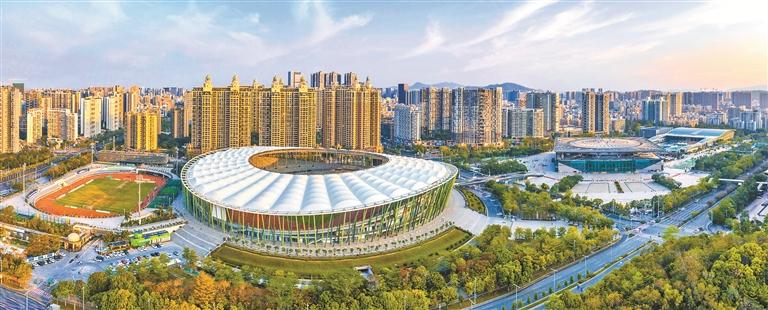
The 15th National Games will open on November 9. As one of the core competition zones, Shenzhen has completed the construction and renovation of all competition venues. As one of the core cities jointly hosting the games across Guangdong, Hong Kong, and Macau, Shenzhen is responsible for organizing 82 competition events. Adhering to the principles of “green, shared, open, and clean” event organization, Shenzhen has prioritized conceptual innovation, supported by design innovation and technological breakthroughs, creating a cluster of sports venues that meet international standards while showcasing urban characteristics.
These sports landmarks, nestled between Shenzhen’s mountains and sea, deeply integrate with the city’s “mountain-sea connectivity” urban planning. They serve as ecological landscapes combining competitive functions with public services, providing strong momentum for Shenzhen’s goal of becoming an “internationally renowned sports city.”
City Development Through Events, Open and Shared
In the first half of this year, 18 competitive sports venues in Shenzhen passed specialized inspections for sports public welfare, information technology infrastructure, and accessibility for athletes with disabilities. Shenzhen became the first zone in the province to have all venues meet standards at once. The remaining temporary venue—the Dapeng Juediaosha Marathon Swimming Venue—is now also ready.
The renovation of Shenzhen’s venues consistently follows the core logic of “revitalizing the city through events and managing the city through events,” deeply integrating event requirements with urban development and public welfare, forming three key planning pillars.
First is the concept of circular development with priority on economy. Shenzhen prioritized renovating existing venues. This “renovate and renew” approach not only significantly reduced construction costs but also minimized construction carbon emissions and environmental impact. The newly built Guangming International Equestrian Center, as the largest wood-structure sports building in China, uses prefabricated construction technology. Components are produced in factories and quickly assembled on-site, greatly improving construction efficiency.
Second is the green, low-carbon life-cycle concept. Shenzhen has integrated green, low-carbon principles throughout the entire process from design and construction to operation. During the design phase, renewable energy utilization and sponge city technologies were incorporated. During construction, prefabricated building methods and BIM technology were promoted. During operation, smart energy management systems were established. For example, Shenzhen Sports Center was designed and built to China’s highest green building standards, featuring advanced material use and energy considerations. Outdoor squares, lawns, and green spaces fully apply sponge city concepts and measures, significantly reducing flood risks during extreme weather while enabling water recycling.
During venue construction or renovation, builders actively researched and deployed solar photovoltaic systems with energy storage facilities, prioritizing self-generation and self-consumption models to maximize the self-consumption rate of photovoltaic power generation. Multiple venues including Shenzhen Bay Sports Center and Bao’an Stadium have installed related facilities, achieving smart energy management through enhanced 5G technology.
Third is the concept of open sharing and integration with public life. Breaking physical barriers between venues and the city, and promoting deep integration of sports spaces with community life, is a distinctive feature of Shenzhen’s planning. All permanent venues have developed post-event reuse plans to ensure 100% utilization after the games. Through “venue + community” and “event + public welfare” functional layouts, professional competition spaces are transformed into public fitness areas and cultural exchange platforms, achieving “multi-purpose, all-hours” shared value.
Technology-Enabled Venues, Creating Smart Benchmarks
In design, Shenzhen’s various competition venues have developed distinctive design languages based on their positioning and event requirements, preserving urban memories while injecting contemporary vitality and Shenzhen’s signature technological elements.
The newly upgraded Shenzhen Sports Center is a prime example of smart rebirth from a traditional landmark. The renovated center aims to become a national benchmark for smart sports venues. It features dual-gigabit networks with comprehensive 5G and WiFi6 coverage, including 4,207 signal antennas and 1,767 wireless access points covering all areas, enabling higher bandwidth and stronger anti-interference capabilities. This allows tens of thousands of spectators to simultaneously enjoy free high-speed WiFi throughout the venue. Artificial intelligence applications include AI security, AI customer service, AI inspection, and a big data-based venue operation decision-making platform, providing comprehensive event safety assurance. The smart energy system includes integrated photovoltaic storage and charging systems, building energy consumption monitoring




